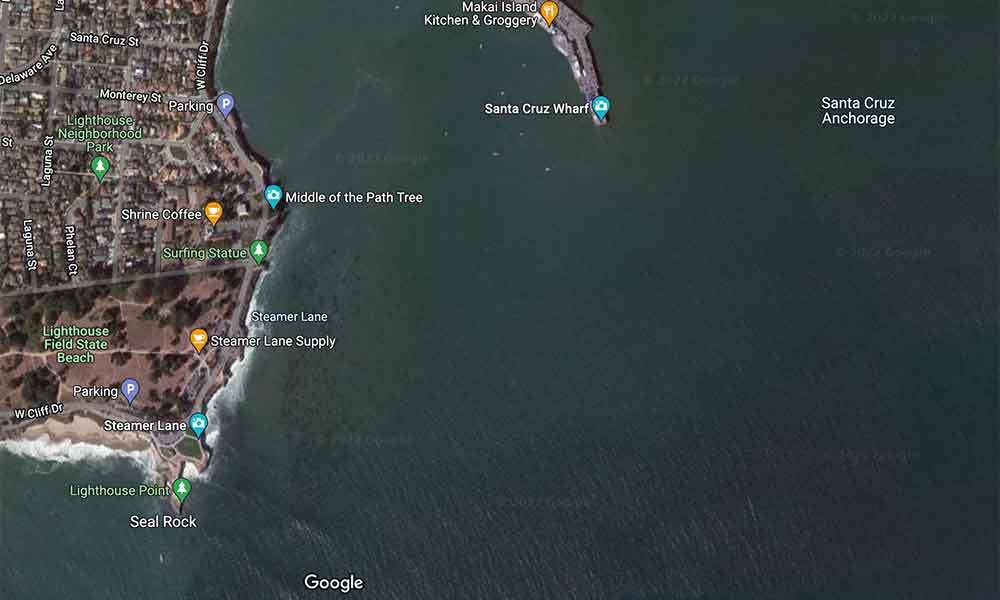Steamer Lane is undoubtedly the most prolific surf spot in Santa Cruz and is responsible for putting Northern California on the list as a top surfing hotspot. Indeed, advanced and pro-level surfers flock to Streamer Lane to put their skills to the test. However, onlookers and surfers unfamiliar with the spot often wonder, “How do surfers get into the Steamer Lane?”
There are two ways to get into Steamer Lane in Santa Cruz. The safest and primary access is via a staircase that travels down the rocks in front of the main parking area, requiring a 500-foot paddle to reach the waves. Alternatively, locals will jump off the bluffs near the Lighthouse Park.
For Northern Californian surfers and surfers from all over the world, surfing at the Steamer Lane in Santa Cruz is a bucket-list-worthy adventure. However, accessing these world-renowned waves doesn’t only take skill; it takes guts! Find out how surfers get into the Steamer Lane, how the spot earned its name, and discover the Four Peaks that put this spot on the map.
How You Get Into Steamer Lane To Surf
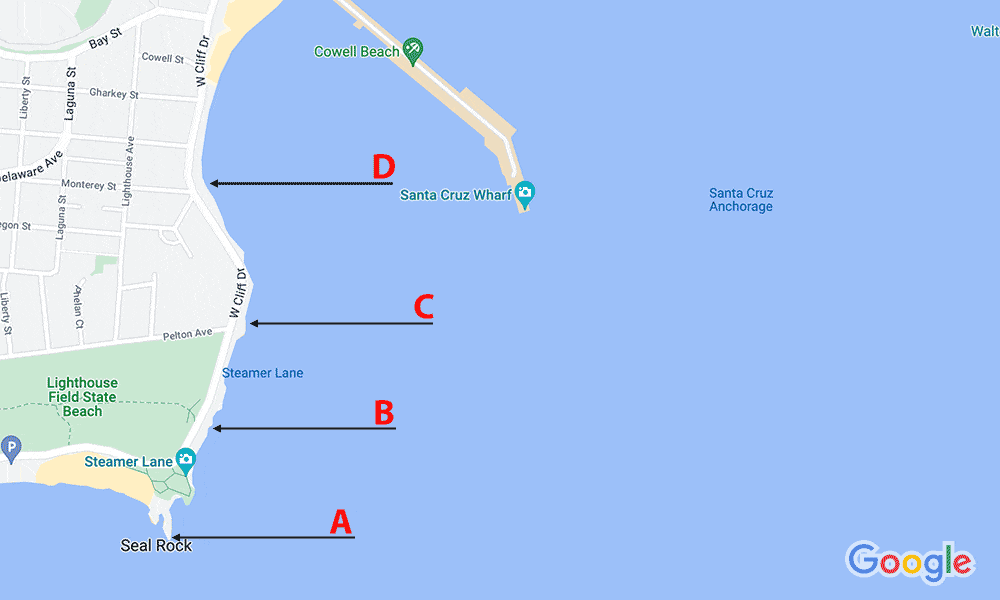
There are two ways that surfers get into Steamer Lane. The first way is via walking down 1 of 3 staircases. The other way is unquestionably far more dangerous and would therefore be irresponsible to recommend to surfers visiting Steamer Lane as it may require jumping off the bluffs near the Lighthouse Point Park – a roughly 30-foot drop.
There are a total of 4 access points to get into Steamer Lane. We will break them down and map them to the image above. You can also use Google Maps and zoom in to see the staircases that connect the side walk on W. Cliff Dr. to the ocean.
Waves are biggest at A and get smaller as you move down the access points of B, C, and D. Smaller can be a very relative term especially in the winter time when the surf at Steamer Lane gets big. Surf to your own abilities at Steam Lane and wear booties for the cold water and the rocks you will need to step on.
Bring you best surf game and be respectful of the locals when you surf Steamer Lane. If you surf well and give respect you will get it in turn. If you don’t surf well or don’t give respect you should expect to be dropped in on minimally.
This is Northern California and there are great white sharks that make themselves known every so often like this one did when it attacked a kayaker just around the corner from Steamer Lane.
Steamer Lane Access Points For Paddling Out
A – Seal Rock
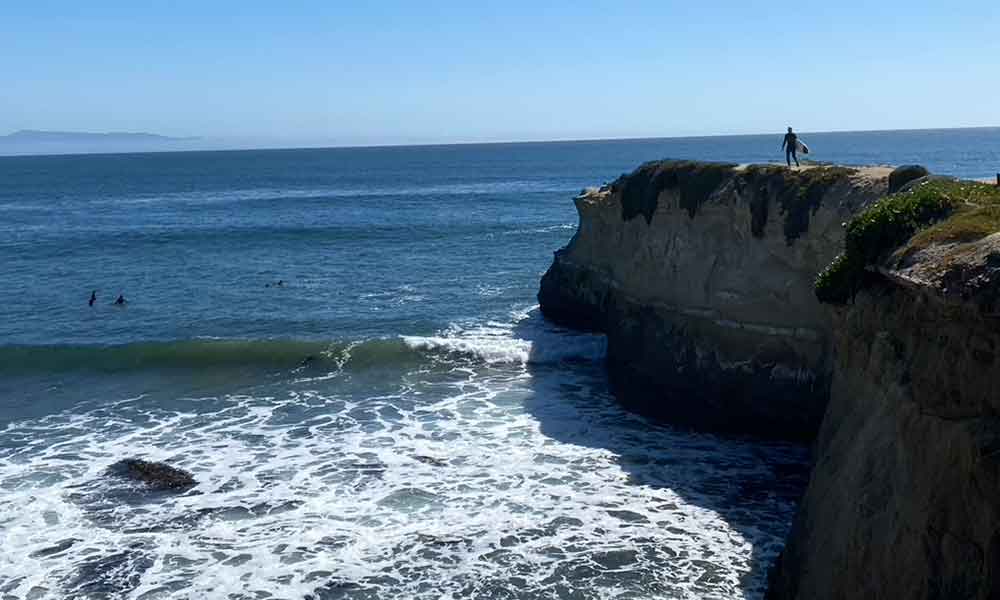
This is for locals only and there are signs that say not to jump the fence, which you need to do in order to either jump off the cliff or walk down the cliff (depending on the tide and surf height) and jump into the water. There are also warning signs about drowning. Waves here tend to be the biggest of the 4 access points at Steamer Lane.
B – Surfers Memorial
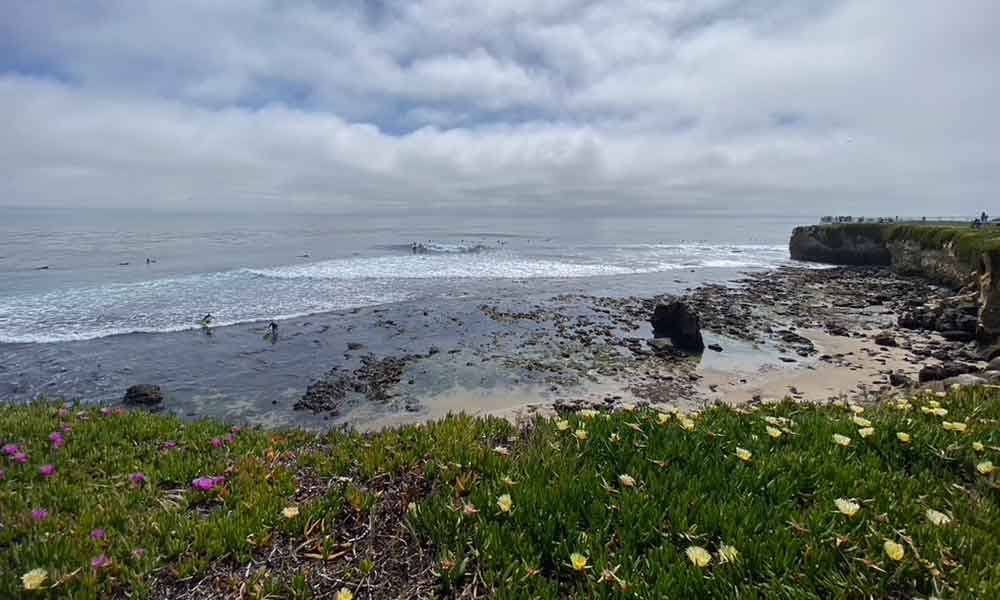
You will see a bunch of flowers and signs at Surfers Memorial. This set of stairs are located across from the parking lot near the bathrooms. You shouldn’t have a hard time find a parking spot 1) during the week, 2) when a swell is on the decline or 3) both of the former. Weekends and summertime are a different story.
When you get to the bottom of the stairs you will need to walk on a bunch of rocks to descend your way down to the ocean. Bring your booties.
Once at the bottom, an intense 500-foot paddle is required to reach the pristine waves, which, of course, necessitates a higher-than-average fitness level and surf experience.
Higher tides and big swells make this entry more challenging due to the amount of water moving around. Lower tides makes this entry point challenging because you will need to walk on a lot of uneven rocks in the shallows and contend with a lot of kelp.
C – Surfing Statue
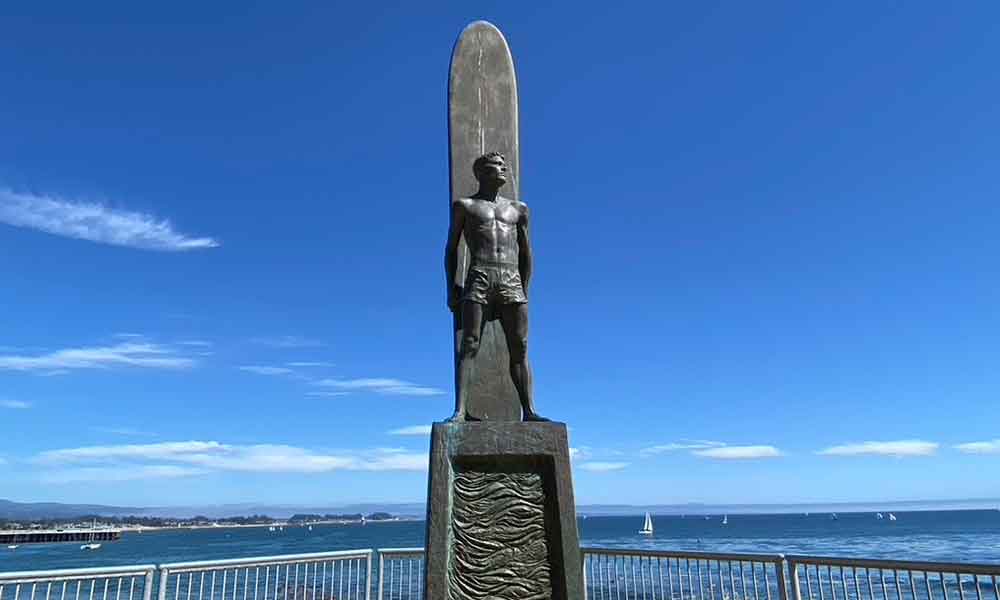
Find the statue of the surfer at the intersection of W. Cliff Dr. and Pelton Ave. The staircase is to the left of the statue if you are looking at pier. The waves will be smaller here depending on the swell and they are still a ton fun with a playful crowd.
D – West Cliff Steps
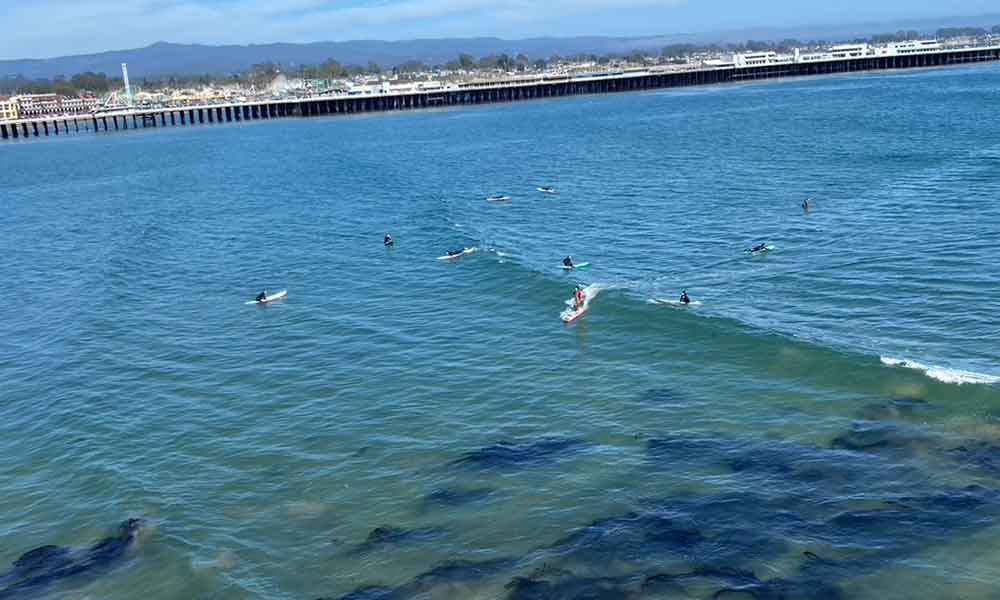
The intersection of Monterey Street and W. Cliff Dr. is the 4th access point at Steamer Lane for surfers.
These steps pretty Indicators surf spot, but if Cowells is not breaking, this is pretty much the smallest ridable way you will find at The Lane. It’s a good spot for beginner surfers and longboarders.
Add Steamer Lane To You Surfing Bucket List
While most world-renowned surf spots are relatively easy to get to, there are a few bucket list-worthy spots that require more than top-notch wave riding skills and require more effort to get to. Steamer Lane is undoubtedly one of those surf spots.
The spot itself plays a significant role in the history of surfing. In fact, history records that Steamer Lane is the surf spot that saw the introduction of shortboards, wetsuits, and surf leashes – items that revolutionized the sport at the time. For these reasons, along with the epic waves, Streamer Lane is Northern California’s surfing hub, drawing surfers and on-lookers from all over the world.
The Santa Cruz surfing museum lies on the bluff only a few feet from the esteemed surf spot and serves as somewhat of a grandstand for the swarms of spectators to watch the surfers in action. It is at this point that many wonder how the surfers reach the waves in the first place since they are watching them from such a high viewing point.
The Four Peaks At Streamer Lane
There are a total of four peaks that make up the surfing hotspot known as Steamer Lane. Although they fall under one spot, each of these peaks has unique characteristics and provides an amazing surfing experience. The Four Peaks at steamer Lane are as follows:
The Point (Access Point A)
Surfing the point requires navigating a very tricky take-off zone. Firstly, the take-off is relatively small, but it’s also where the waves come crashing into a jutting rock. Timing is everything at The Point.
However, while the risk is higher, the reward is even greater. Surfers can expect pristine four-to-six-foot hollow righthand waves. The Point is the furthest break at Steamer Lane, with waves breaking near the tip of the Lighthouse Point.
The Slot (Access Point B)
The Slot is arguably the most popular wave at Steamer Lane. It is a high-performance, fast wave that often provides excellent tubing opportunities. You will undoubtedly find a lot of surfers competing for The Slot waves when visiting Steamer Lane.
The Middle Peak (Access Point C)
The waves at The Middle Peak break even further out than the Slot. However, under good conditions, you can expect perfect A-frame waves towering well over-head – double over-head in some cases.
It might not be the most consistent part of Steamer Lane, but when this spot has been supercharged, only the most experienced big-wave surfers should think about attempting these powerful waves.
Indicators (Access Point D)
The waves at Indicators are only great when they’re massive. When they’re of a substantial size, they provide the longest ride at Steamer Lane – a roughly 200-yard surf!
Be warned, though, that you need a serious amount of paddling fitness to navigate these waters. Once again, though, the reward will be well worth it.
Why Is It Called Steamer Lane?
So, now that you know how surfers get into Streamer Lane, another frequently asked question is how this world-renowned surf spot came to acquire its peculiar name. It is not uncommon for surf spots to have relatively strange names, though there is almost always an exciting backstory – or conspiracy theory – as to how these places got their quirky names.
Popular surf spots like Supertubes in Jeffery’s Bay or Jaws in Hawaii offer a reasonable amount of insight into the nature of the spots through their names, but Steamer Lane? Most surfers are left absolutely clueless as to why that became the name of this epic surf spot. Well, the answer is less factual and more so based on conspiracy – two similar conspiracies, actually.
The first theory – which seems somewhat unlikely – is that in the 1930s, two surfing buddies decided to rent steam-powered boats in an attempt to generate epic surfable waves by cruising the boats back and forth along the water. A noble idea, you must admit, but it undoubtedly couldn’t have taken long to realize that the idea wasn’t working as well as they had hoped.
The second theory retains the theme of steam-powered boats. Steamships used to frequent the area yet would do their best to avoid the massive surf that was common in the area. So, the story goes that Steamer Lane got its name simply because the large waves occurred in the same “lane” as the steamships in the area.
We would say that the second theory, as simple as it seems, is far more likely to be the true origin of the iconic surf spots name.
Conclusion
All in all, Steamer Lane requires some great skill, determination, and guts to be able to reach. Whether by stairs, followed by a 500-foot paddle, or a death-defying 30-foot drop, getting into Steamer Lane isn’t for the faint of heart, but the reward of surfing these world-class waves will be well worth it!

